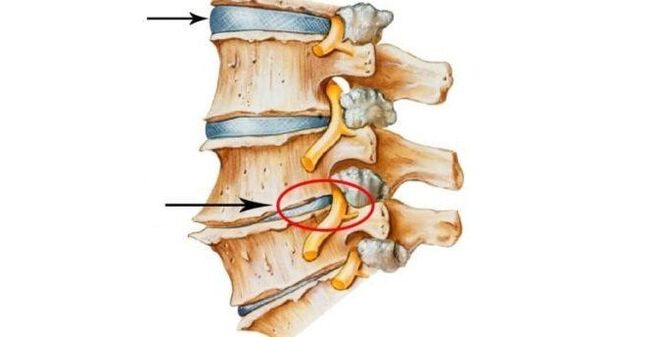With osteochondrosis of the cervical spine, rapid aging of the intervertebral discs and cervical vertebrae occurs. The main symptoms are dizziness and headache. Changes most often occur in the most mobile parts of the spine.

Cause
The fact that osteochondrosis only develops in old age is a mistake. In recent years, signs of cervical osteochondrosis have been found in young people aged 16 to 20 years. The onset of the disease is caused by the following reasons:
- Violation of metabolic processes.
- Abuse of tobacco and alcohol.
- Low physical activity (hypodynamics).
- Injuries.
- Prolonged sitting position.
- Overweight.
- Sleep disorders.
- genetic predisposition.
Symptoms of cervical osteochondrosis are often confused with cold or banal fatigue. If signs of the disease appear, a doctor should be consulted as soon as possible.
Symptoms
There is a syndrome in which damage to the spinal roots, narrowing of the veins and arteries passing through the vertebral body. Cervical sciatica (radical syndrome) is manifested by numbness of the shoulder blades, shoulders and arms, as well as pain and tingling. Discomfort is felt in the neck and chest (front).
The first signs of osteochondrosis of the cervical vertebra are:
- mild pain in the neck;
- crackling when turning, turning;
- intermittent pain in the head and neck, difficulty in the back of the head, numbness in the arms and shoulders.
Dizziness is a symptom of cervical osteochondrosis that occurs at night or in the morning after waking up. For dizziness to occur, it is sufficient for the patient to rotate his head several times.
Dizziness occurs with:
- loss of orientation in space;
- the feeling of "staggering the floor" under the feet;
- loss of balance;
- noise and ringing in the ear;
- nausea and vomiting;
- redness or pallor of the face;
- headache and increased sweating.
Dizziness causes blurred vision, increased heart rate, numbness of the hands, the appearance of "flies" in the eyes.
Prevention of dizziness is with proper nutrition (with the right vitamin B and C content) and the right sleep arrangement (low pillow, hard mattress). Drug therapy for dizziness is aimed at normalizing blood circulation to the brain.
Exacerbation of the disease
Symptoms of worsening osteochondrosis of the cervical spine may include:
- Pain in the occipital region and neck that passes through the arms, shoulder blades and shoulders.
- Increased pain during head movement, sneezing, coughing.
- Head restraint (for pain relief).
- The pain can be localized in different places, which interferes with the diagnosis.
- Prolonged headache and dizziness.
- Violation of vision, hearing, movement coordination.
- Increased muscle tone in the limbs and neck in the background of general weakness.
- Decreased skin sensitivity (numbness, dryness, tingling, cold).
- Sleep disorders, memory problems, increased anxiety.
Diagnostic methods are used to check the condition of the cervical vessels - duplex scanning or ultrasound dopplerography.
Complications
Symptoms not detected and treated untimely can lead to the following complications:
- Protrusion (protrusion) between the vertebrae of the cervical spine.
- Injury to the cervical region (intervertebral).
- Radiculopathy (damage to one or more nerve roots).
- Development of large osteophytes in the cervical spine.
- Paresis (not complete paralysis).
- Narrowing of the arteries that supply the brain.
- Contracture of Dupuytren. With pathology, the palm is deformed, the fingers are compressed, and the hand ceases to function normally.
Osteochondrosis and VVD
Symptoms of VVD (vegetovascular dystonia) in cervical osteochondrosis are interrelated. These pathologies are chain links in the same chain that require increased attention, diagnosis, and treatment. Often, vegetovascular dystonia is a consequence of cervical osteochondrosis.
Dystonia has the following symptoms:
- Dizziness.
- Heart palpitations and pain in the heart region.
- Breathing disorders (increased breathing, shortness of breath).
- Blood pressure drops.
- Disorders of the internal organs (stomach, intestines, urinary tract).
- Changes in body temperature during the day (35-38 degrees).
- Irritability, tearing, anxiety.
The cause of vegetovascular dystonia can be hormonal insufficiency, endocrine disorders, overweight, genetic predisposition. The main symptoms of VVD in cervical chondrosis are muscle fatigue, impaired body control.
The presence of these signs requires a correct diagnosis and is only possible after a full examination. Self-treatment of the disease is unacceptable!
Diagnostics
The investigation begins with an investigation and analysis of all the patient's complaints. The diagnosis makes it possible to rule out diseases of the heart and blood vessels, stomach and intestines. The diagnostic measures are as follows:
- Radiography.
- CT (computed tomography).
- MRI (magnetic resonance imaging).
- Myelography.
A neurological examination is performed to determine the extent of sensory and motor disorders.
Treatment of the disease
Therapeutic measures are aimed at eliminating inflammation in the affected area and relieving pain. The drug regimen is represented by the following groups of drugs:
- NSAIDs (non-steroidal anti-inflammatory drugs).
- Chondroprotectors - drugs that stop the destruction of cartilage and help to restore cartilage tissue.
Treatment with ointments is very common but ineffective. During self-medication, patients use ointments containing irritants or ointments belonging to the NSAID group. The healing substance in the ointment cannot penetrate the site of injury through the dense layer of skin and muscles.
A significant advantage of ointments in neck massage while rubbing the drug.
Symptoms of cervical osteochondrosis are treated with B vitamins. The combination formulation for intramuscular administration is well established. The composition of the solution contains B vitamins: cyanocobalamin (B12), pyridoxine (B6), thiamine (B1).
The complex treatment includes: physiotherapy, acupuncture, hirudotherapy (treatment with leeches), massage, gymnastics (physiotherapy), manual therapy.
In this video, we present the practical therapeutic complex of the neck. Performing these exercises daily will help you get rid of the unpleasant symptoms.
Disease prevention
To prevent the development of osteochondrosis of the neck, it is recommended to warm up regularly during work, avoid neck stress, do not perform sudden head movements, pay attention to posture, avoid hypothermia, exercise and proper eating.



















